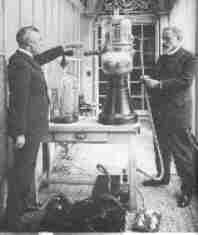In 1868, Helium was discovered in spectrographic analyses of the sun.
It was the first of the "noble" gases to be discovered.
It obtained its name from the Greek word
helios for "sun".
The next to be discovered was Argon, which was isolated and identified
by Rayleigh and Ramsay in 1894.
It took its name from the Greek word
argos
meaning "inactive".
It, along with helium, neon, xenon, krypton, and radon,
are the "noble" gases, so called because they are inert
and do not form compounds like the other elements.
This was shown to be not strictly true in 1962,
when researchers managed to combine xenon and fluorine into xenon tetrafluoride.
In 1897, William Ramsey predicted the existence of the element neon.
He and Morris Travers discovered it in the atmosphere in 1898,
and they named it after the Greek word for "new": the new gas.
 Enter Georges Claude,
who in 1910 found that passing electricity through neon yielded
a brilliant red light.
Intrigued, he took a Moore tube and filled it with neon
and immediately obtained the first true neon tube.
Neon, being inert, did not combine with other tube elements,
so the gas valve wasn't necessary with this new gas.
Claude also developed the process of extracting neon
from the atmosphere by liquifying air,
yielding extremely pure neon in useful quantities.
Claude's third contribution to neon technology was the
invention of nonreactive electrodes large enough to
handle the ion bombardment without heating or sputtering,
opening the way to long life, maintenance free tubes.
Enter Georges Claude,
who in 1910 found that passing electricity through neon yielded
a brilliant red light.
Intrigued, he took a Moore tube and filled it with neon
and immediately obtained the first true neon tube.
Neon, being inert, did not combine with other tube elements,
so the gas valve wasn't necessary with this new gas.
Claude also developed the process of extracting neon
from the atmosphere by liquifying air,
yielding extremely pure neon in useful quantities.
Claude's third contribution to neon technology was the
invention of nonreactive electrodes large enough to
handle the ion bombardment without heating or sputtering,
opening the way to long life, maintenance free tubes.
Obviously, the bright red tubes weren't very useful as
a general purpose light source,
but the eyecatching colour and its ability to penetrate
through rain and fog made it a natural for advertising.
Claude patented the inventions and incorporated Claude Neon.
In 1922, the Haaxman brothers brought the first neon signs
to Holland.
In 1932, the first neon signs reached the United States.
These blue and red signs, for a Packard dealership,
stopped traffic from the moment they were installed,
and launched a thriving neon industry that survives to this day.
John Rehwinkel
spam@vitriol.com
 Enter Georges Claude,
who in 1910 found that passing electricity through neon yielded
a brilliant red light.
Intrigued, he took a Moore tube and filled it with neon
and immediately obtained the first true neon tube.
Neon, being inert, did not combine with other tube elements,
so the gas valve wasn't necessary with this new gas.
Claude also developed the process of extracting neon
from the atmosphere by liquifying air,
yielding extremely pure neon in useful quantities.
Claude's third contribution to neon technology was the
invention of nonreactive electrodes large enough to
handle the ion bombardment without heating or sputtering,
opening the way to long life, maintenance free tubes.
Enter Georges Claude,
who in 1910 found that passing electricity through neon yielded
a brilliant red light.
Intrigued, he took a Moore tube and filled it with neon
and immediately obtained the first true neon tube.
Neon, being inert, did not combine with other tube elements,
so the gas valve wasn't necessary with this new gas.
Claude also developed the process of extracting neon
from the atmosphere by liquifying air,
yielding extremely pure neon in useful quantities.
Claude's third contribution to neon technology was the
invention of nonreactive electrodes large enough to
handle the ion bombardment without heating or sputtering,
opening the way to long life, maintenance free tubes.